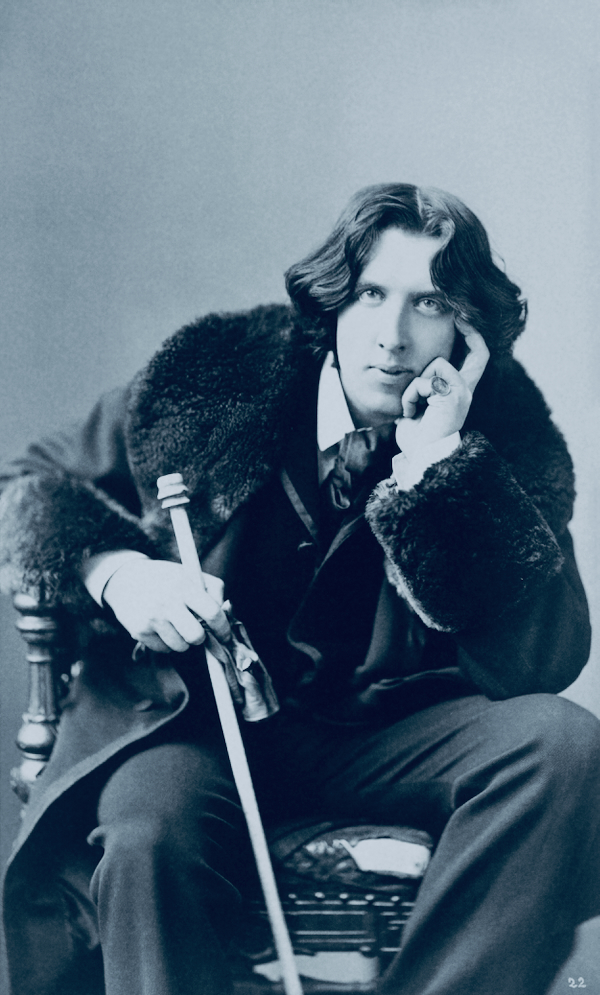
Oscar Wilde was controversial almost from the start. The languid pose he struck during his days at Magdelen College, Oxford in the 1870s would become the foundation for a quintessential outre type. The aesthete, that longhaired, beret-wearing lover of art and adorer of things beautiful, is even today the ubiquitous tenant of college campus coffee houses, gallery openings and cafes from Prague to San Francisco.
We’ve grown used to him. But in the straight-laced atmosphere of Victorian London, the aesthete produced shock and dismay in some, awe and fascination in others. The press of the time, particularly popular middles-class periodicals like Punch, was quick to note the trend, publishing satirical cartoons that poked fun at the aesthete’s wan-and-drawn pose. These usually featured some droopy young man in Little Lord Fauntleroy costume rhapsodizing over the perfection of a lily to his muse, usually a droopy young woman.
By the time Wilde left Magdelen he was already a celebrity, although he had done little in terms of literary production. To his credit he had won the Newdigate Prize for his poem “Ravenna,” and published a slim volume of mostly forgettable verses under the clever title of “Poems” in 1877. But Wilde’s real medium was not, in his youthful days, the written word but the spoken. His venue was the dinner table and drawing room of fashionable London. His weapons of choice were the epigram and the aphorism, exquisitely worded and skillfully placed.
Thus Wilde became the quintessence of a second type: the celebrity famous for little more than being famous. Had he lived in later times he might have made a comfortable living occupying the center box on Hollywood Squares, trading quips with George Hamilton. There were no quiz shows in the 1880s, but that didn’t stop Wilde from increasing the size his audience from a drawing room to an auditorium. His new venue, the lecture circuit, was then the most popular form of entertainment next to the music hall. D’Oyly Carte, a promoter of operettas, tapped Wilde to help promote Gilbert and Sullivan’s “Patience,” a musical that made lighthearted fun of Wilde and his aesthetic circle across North America. He traveled through the United States, a week or two ahead of the show, lecturing American audiences on the virtues of the beautiful in everyday life and at the same time familiarizing them with the aesthete character. It was a brilliant marketing strategy for both parties. “Patience” made a nice profit, and Wilde went back to England rich enough to keep himself in style (for a while, at least) and to make a respectable proposal of marriage to a wealthy young lady, Constance Lloyd.
Wilde knocked around London a bit, serving as editor for The Woman’s World and penning reviews for the Pall Mall Gazette. With the publication of his collection of children’s stories, “The Happy Prince and Other Tales” in 1888, Wilde began to see some modest critical and commercial success. His only novel, the half-dandy, half-gothic, “The Picture of Dorian Gray,” was first serialized in an American magazine in 1890 and then appeared in a hardbound edition in England the following year. It was a popular book, thanks in large part to the many critics who condemned it as immoral.
A new transformation began to take place in Wilde in the late ’80s. He spurned his trademark knee breeches and adopted long trousers. He cut his long locks. He replaced his velvet jackets with more respectable frock coats. In short, he rejected his youthful aesthete’s pose in favor of a more contemporary expression of dandyism.
Perhaps it was the pressure of being a father. Constance had borne him two sons, Cyril (1885) and Vyvyan (1886), and made him the head of a household with bills to pay. Or perhaps he felt the wind’s subtle shift as the century drew to its close and Victorian restraint slowly ebbed in favor of Edwardian worldliness. Probably it was a bit of both, combined with the realization that, as the Yellow Nineties dawned, the aesthete pose had ceased to be an outre one. It was now merely annoying — and considerably less marketable in an atmosphere where “decadence” had become the rule rather than the exception.
Wilde’s transformation was not merely sartorial. It was also artistic and intellectual. All but gone was the adolescent preoccupation with Pre-Raphaelite fantasy. Poems extolling the aesthetic virtues of a sunset or gushing over the details of a Greek statue gave way to poignant, sophisticated and highly contemporary comedies of manners.
The plays came in rapid succession, one after another, and each took London’s dramatic world by the hair. “Lady Windermere’s Fan” opened in 1892. It was a smashing success. “A Woman Of No Importance” appeared the following year. “An Ideal Husband” and his most oft-revived play, “The Importance Of Being Earnest,” both came out in 1895 to good reviews and handsome receipts.
Where the aesthete’s view had been concentrated inward, Wilde’s mature view trended outward. With the flaneur’s keen eye, Wilde, through his seemingly simple romantic comedies, picked Society apart with a scalpel, exposing its follies and foibles with a touch both deft and light. Through quip and wisecrack, paradox and bon mot, Wilde exposed those little truths that sent audiences tittering and blushing at the same time with simultaneous ripples of titillated befuddlement and guilt-addled pleasure. They still do.
Wilde is one of the most talked-about and written-about playwrights since William Shakespeare, and at any given moment at least one of his plays is either in production somewhere in the world. Recent film releases have given “The Importance of Being Earnest” and “An Ideal Husband” stylish new treatments. And Wilde’s life itself has been the inspiration for numerous works. These include Walter Satterthwaite’s “Wilde West,” a novel that turns the aesthete’s American tour into a Wild West detective story; Moises S. Kaufman’s “Gross Indecency: The Three Trials of Oscar Wilde;” the film “Wilde” starring Stephen Fry; and, most recently, “Oscar Wilde: The Musical.”
Almost every biography, article, play, epitaph or eulogy created about Wilde somewhere mentions his dandyism. It can’t be helped. Oscar was many things, but at his height he was above all things a dandy. — MICHAEL MATTIS

My interest is in Neodandism . Have you heard of the fashion company by the name Neodandi? The philosophy behind this is called Neoillusion, which is the contemporary outlook on the nature of reality itself. Neoillusionism is the out look which sees the world as essentially non-existent and the universe as holographic projection of the true reality, whose nature is essentially the spirit, and whose true reality is what the movement call The Real. In other words , there is no reality except The Real . It’s nature is the quantum reality and ultimately unknowable, for it is infinite in its propagation and the holographic natures of its projection can only get hold of it through the spirit, in other words it is spiritual and it is everything that implicates this nature, which is the creation it’s self in all of its implied universes. Neodandism is its outward appearance and its practice is Neoillusionism. Neodandis dress to reflect this reality, as the true luxury of the Age , therefore true luxury is spiritual. In fact , there is no any other luxury other than that.